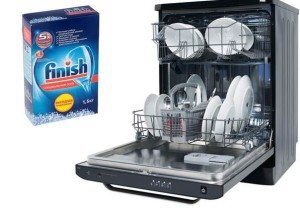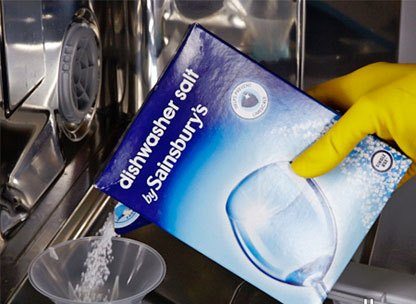Where and how much salt to pour in the dishwasher?
 The dishwasher does an excellent job with dirty dishes, but it requires various means for this, so be prepared to buy them constantly, spending a certain amount from the budget. All the means used can be divided into two groups: those that are necessary for washing off contaminants, and the second group of means is means for softening hard water, or rather salt. A further narrative will go on how much salt, where and how often you need to pour salt into the dishwasher.
The dishwasher does an excellent job with dirty dishes, but it requires various means for this, so be prepared to buy them constantly, spending a certain amount from the budget. All the means used can be divided into two groups: those that are necessary for washing off contaminants, and the second group of means is means for softening hard water, or rather salt. A further narrative will go on how much salt, where and how often you need to pour salt into the dishwasher.
A variety of salts - how much to pour
Before answering the question of how much salt to pour in the dishwasher, we will determine what salt you use for this. There are several options:
- special regenerating salt (for example, Finish, Somat, Calgonit, etc.);
- special tableted salt (Topperr);
- a substitute for special salt - Extra boiling out salt, we already talked about the pros and cons of salt replacement in an article about how to replace salt;
- tableted salt based on the Extra salt.
Instructions for use are written on the packaging of specialized salt, which states that salt should be poured into the tank to the top. Depending on the model of the dishwasher, the volume of the salt compartment may be different, so a different amount of salt may enter. Most cars fit 2/3 of a half kilogram pack of regenerating salt.
As for ordinary salt, one kilogram pack is enough. Pills should also be scattered so that the container is full. How often you need to add salt - the dishwasher itself will tell you by flashing the salt indicator. When it lights up, you need to fill in the salt again.
Salt compartment
The question of where to pour salt in the dishwasher should not cause difficulties. In all dishwashers, the salt compartment is located at the bottom of the dishwasher under the lower tray. To pour granular salt into it, you need to use a funnel.
Important! When salt is poured into the dishwasher for the first time, you must first fill the compartment with water. As salt is poured, excess water will go into the sewer.
As for the 3-in-1 tablets containing salt, a special compartment is provided for them. It is located on the inside of the door.

Water hardness and salt consumption
To soften the water in the dishwasher, there is a special device in the form of a tank called an ion exchanger. Inside the ion exchanger is a resin with negatively charged chlorine ions. These ions attract the impurities of magnesium and calcium contained in the water, the water becomes softer. If this is not done, then at high temperatures, magnesium and calcium form a scale that deposits on the ten, in addition, in hard water, dishes are washed worse
But if the water in the dishwasher, passing through the ion exchanger, becomes soft, then why do we need special salt? And then, in order to restore the amount of chlorine ions in the resin, that is why such a salt is called regenerating. And the more hard water, the more salt will be consumed.
To determine the hardness of water, you can use one of the following methods.
- The method is "by eye", that is, take laundry soap, foam or soap them with some kind of rag. If it is poorly soaped and poorly rinsed, then the water is hard. In addition, pay attention to how quickly limescale appears on taps, in the toilet and other surfaces. The faster, the harder the water.
- The second method involves the use of a special device or test strip. The most accurate and easiest option.
Important! Water hardness varies according to the seasons of the year, so it is best to conduct your own measurements several times a year.
- And the last method offers us to look at the rigidity in the table by region, compiled by specialists.
According to hardness, water is classified into:
- soft;
- medium hardness;
- tough;
- very tough.

How to properly adjust the salt intake in a dishwasher according to water hardness? First, study the instructions, usually the whole process is described in it. So, for example, in Bosch brand dishwashers, you can set 7 levels of water hardness. When the salt runs out, the indicator on the panel lights up, which means that you need to fill the salt again. If you use tablets containing salt, then the salt-free indicator can be turned off by setting the water hardness to 0.

But note, even among Bosch machine models, when the hardness is set to 0, water can pass not bypassing the ion exchanger, but through it. And if you do not fill in the salt, and put only tablets containing salt, then this can lead to the ion exchanger clogging and the water will not flow at all, as a result, the unit will need to be changed. Therefore, salt is needed not only to soften water and improve the quality of washing, but also to maintain the ion exchanger of the dishwasher in working condition.
Important! Bosch dishwasher manufacturers recommend 3-in-1 tablets only with a hardness level of less than 210dH, if the hardness is greater, then it is necessary to pour salt and detergents separately.
Thus, it is not so important how much salt is poured into the dishwasher compartment, it is important that it is always there. And how often you have to do this will depend on the hardness of the water in the region and whether the hardness settings on the dishwasher itself are set correctly. We hope you find this article helpful.
Interesting:
13 reader comments
Add a comment Cancel reply
Headings
Washing machine repair


For buyers
For users

Dishwasher


















I unscrewed the lid from the compartment, where to pour salt, and water, literally under pressure, spilled out of the hole. Moreover, the machine is now very poorly washing dishes. Maybe she’s broken or clogged? Tell me please.
Hello, the same story, what I do not know ...
The water in the salt compartment should be constant, just pour salt and water flows out. Without salt and rinse, it will always be bad to wash.
Do not wash dishes, what to do? And in the salt compartment a neck of water, how to add salt?
Just fill the salt, water will flow into the drain! So it should be)))
I, somehow, water flowed out of the tank, there was only salt left. Now, before loading the machine, do you need to pour water or will she herself pick it up there?
Powder for the dishwasher accidentally poured into the salt compartment. What now? Will the machine go bad now?
The articles write that this is bad. May break. Be sure to contact the workshop. They will come or tell me by phone.
And where to pour the gel? In the same compartment as the pill?
Yes
At the first start, the dishwasher did not pour water, but simply sprinkled salt. After half an hour, washing from 3 hours of the cycle began to squeak and issued an e4 error. When I read that you need to pour water into salt. I did it. Now when you open the lid in the compartment with salt, the water is under the neck. Could this error be due to the fact that I did not pour water.
Salt ended after 6-7 washes. Those. the lack of salt indicator lights up. Before the 1st load, 1 kg was poured, as indicated in the instructions with water. She spent so quickly? The Electrolux machine with 10 indicators of rigidity. Hardness 8. Who how often does the salt fall asleep?
Natalia, I also have about the same.